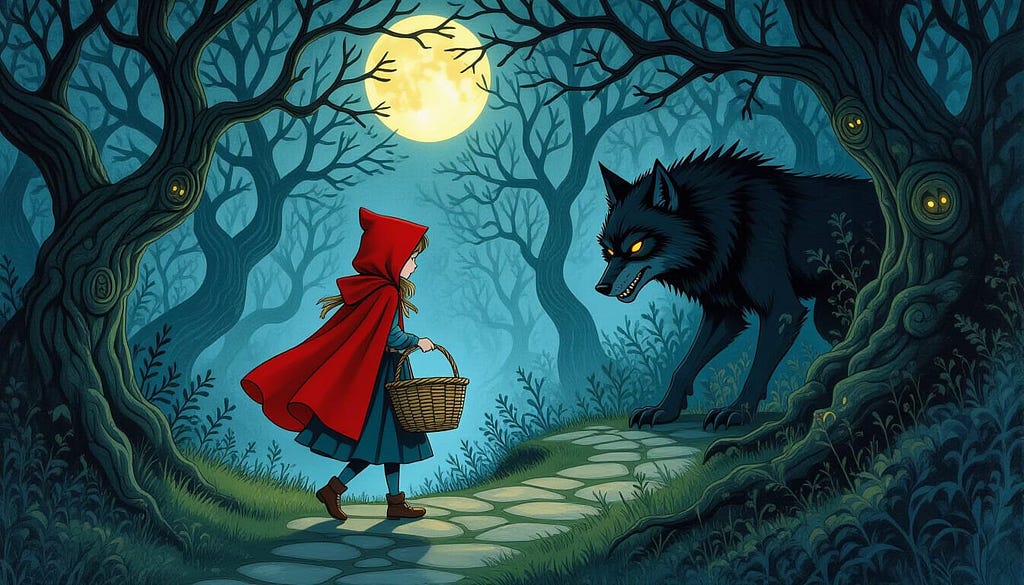From Little Red Riding Hood to Amazon Web Services, the stories we inherit shape how we see risk and opportunity. This article explores how cultural conditioning and organisational habits keep us clinging to the core — the safe, well-worn path — even when innovation strategy and growth beyond the core demand we step into the unknown. Featuring insights from Wendy K Smith, Gary Hamel, David Rogers, Charles Conn and Elise Loehnen, we’ll see why the sweetest growth is often found on the limb, where the fruit hangs just out of reach.
“Every one of us is conditioned and caught in a system that we cannot see — but its effects are suffocating and deadening. We are so used to functioning in this structure that it’s only when we attempt to break free that we can feel just how tightly we’ve been restrained.” — Elise Loehnen
Like so many things in life, we rarely appreciate an experience in the moment. It is only months, years, and decades later that we realise how valuable they are and how they influence our thinking.
I studied French in college and part of that course was French literature. One of the classes focussed on “Le Petit Chaperon Rouge”, the well-known fairytale “Little Red Riding Hood”. We examined the many variations and adaptations of the story as it evolved throughout history. I never thought I would ever revisit this subject ever again and yet here it goes.
This Thursday Thought looks at the vital importance of the stories we tell ourselves and more importantly, the stories we pass on to future generations. These “stories” inform our worldview and give us certain perceptions of the world. Such stories condition us and have a major influence on how we navigate the world and make sense of it. These frames shape our thoughts, behaviours and mindsets. They direct our lives, we live our lives to scripts that we have not even written. This counts as much in business as it does in life.
Le Petit Chaperon Rouge

“Are you thinking that children don’t know better? That we need to train them so that they stay safe, accepted, and successful? That they don’t know the right way to respond to the world? It seems to me that we are born vibrant, strong, and resilient. And most of the advice from the social world has made us worse. Fearful, dependent, and fragile.” — Tom Asacker
Skip this paragraph if you remember the fairytale.
Dressed in a red cape, a young girl, Red Riding Hood, walks through the dark woods to deliver food to her sick grandmother. Her mother orders her to stay strictly on the beaten path. A Big Bad Wolf stalks her from the undergrowth. When he approaches Little Red, she innocently tells him where she is going.
The wolf suggests she pick some flowers for Granny and wander off the beaten track. Once she does, he races ahead to Gran’s house, pretends to be Little Red at the door, is welcomed in and swallows Gran whole. Next, he disguises himself as a granny and awaits Red. On arrival, Red notices that Gran looks odd. Soon enough, the wolf jumps out of bed and devours Red. Once full, he nods off to sleep. In some versions, the story ends on this sombre note. In other variations, there is a rescue where a woodcutter cuts open the sleeping wolf and both Red and Gran emerge unscathed. The woodcutter fills the wolf’s body with heavy stones to kill him.
Milder versions still have the gran locked in a closet instead of being swallowed whole and others have Red saved by the lumberjack as the wolf stalks her rather than after she gets eaten, avoiding the gory details altogether.
The Moral of the Story?

In Charles Perrault’s “Tales of Mother Goose”,1697, he explained the ‘moral’ as follows:
“From this story, one learns that children, especially young lasses, pretty, courteous and well-bred, do very wrong to listen to strangers, And it is not an unheard thing if the Wolf is thereby provided with his dinner. I say, Wolf, for all wolves are not of the same sort; there is one kind with an amenable disposition — neither noisy, nor hateful, nor angry, but tame, obliging and gentle, following the young maids in the streets, even into their homes. Alas! Who does not know that these gentle wolves are of all such creatures the most dangerous”.
While Perrault highlights the dangers that await young women by predatory men, the overarching theme highlights the safety of the village versus the dangers of the forest. It serves to warn children about the dangers of straying from the beaten path.
We grow up on stories like Little Red Riding Hood. They’re told as cautionary tales: stray from the path and you’ll meet the wolf. The lesson is drilled in early — safety lies in following the rules, sticking to what’s known, staying on the beaten track.
That conditioning doesn’t stop when childhood ends. In corporate life, we’re still walking the well-worn path. We are conditioned to cling to the core.
Sticking to The Core

Gary Hamel writes in ‘Leading the Revolution’, “Most management processes are biased toward conservation rather than growth. They tend to put a premium on efficiency and undervalue experimentation aimed at exploring new competitive space. Ideas for trying something new and out-of-bounds are implicitly viewed as dangerous diversions from the central task of driving down costs and building market share in the core business. I have seldom seen a management process that explicitly challenges managers to develop and test a portfolio of unconventional strategic options. In general, management processes are focused on minimizing variances rather than maximizing opportunities.”
Just as Little Red is warned to stay on the path, Gary continues, “In ways subtle and not so subtle, management processes perpetuate the status quo. Champions of business concept innovation will, invariably, find themselves working against the grain of key management processes. Most management processes are focused on existing customers and markets. Again, there is a subtle bias toward serving existing customers better, rather than finding entirely new types of customers.”

It is only in exploring beyond the incremental path, that a business can find transformative growth. As the saying goes, Why not go out on a limb? Isn’t that where the fruit is?
The challenge for innovation in an established company is managing resource allocation outside off the beaten track. This is what friend of The Innovation Show, David Rogers calls the challenge of proximity. (David will join us again soon on the show) Once a company becomes successful, there is an inherent tension between staying the path and exploring the unknown. In many firms, this tension is often resolved by staying close to the path, with maybe the occasional excursion into the woods. As David puts it in ‘The Digital Transformation Roadmap’, “Every business needs to place bets on innovative ventures outside its core if it hopes to achieve sustainable long-term growth. As its existing business model matures and loses the potential for growth, innovation of this kind is critical.”
As Wendy K Smith and Marianne Lewis explain in ‘Both/And Thinking’, Leaders get caught in a pattern of either/or thinking, “Either they held onto their long-successful strengths or they shifted to new ventures, risking all that they had worked to create. It was this either/or thinking that was the actual risk.” In our current series on Resource allocation with Joe Bower, Clark Gilbert and Robert Burgelman, we explore a growth challenge in the core, where an overinvestment in the core business (the path) often means a diversion of resources away from promising new ventures, an either/or choice. David Rogers suggests a “Both/And way” to counter this challenge is to “Keep an umbilical cord.” He says, “As important as independence is, a growth venture beyond the core business should never be left to sink or swim entirely on its own. These ventures still need access to critical assets and resources from the parent firm.”
A great example of this umbilical cord approach and a controlled venturing beyond the core path comes from Amazon’s 15-year expansion into the world of consumer and merchant financial services. A story shared with us by Charles Conn from his book, ‘The Imperfectionists’ co-authored with Robert McLean.
Amazon Steps Beyond the Path

There’s a key to adventuring you don’t get it by winning, you get it by wandering around in a dark room.” — Ernest Cline, Ready Player One
Amazon’s expansion beyond its core business, with examples such as Amazon Web Services, consumer financial services, and recent healthcare ventures, has made traditional strategic frameworks obsolete. It was not about following a rigid path from a business school textbook. Amazon doesn’t need a perfect strategy in a constantly changing world. Instead, they set bold goals and take small steps forward, like climbing a staircase. Each step helps them better understand the changing landscape, improves their understanding, and sometimes leads to acquiring valuable assets like intellectual property or smaller companies. In essence, they build capability with controlled reconnaisance forays beyond their well-trodden paths. It is only through this approach do they discover the fruit.
In his 2005 annual letter to Amazon shareholders, Jeff Bezos wrote, “Many of the important decisions we make can be made with data. There is a right answer or a wrong answer, a better answer or a worse answer, and math tells us which is which.” But sometimes, he added, “We have little or no historical data to guide us and proactive experimentation is impossible. . . . Though data, analysis, and math play a role, the prime ingredient in these decisions is judgment.”
We were taught to keep to the path, but this conditioning is not destiny. If we want genuine innovation strategy and growth beyond the core, we must recondition our organisations: adopt both/and thinking — protect the core while placing deliberate bets beyond it; keep an umbilical cord of shared assets and capabilities (your Hansel-and-Gretel breadcrumbs back).
In every aspect of life you can never be sure if there is fruit out on the limb, there is potential beyond the path and growth beyond the comfort of the core, the only way to find out is to explore.
This week on The Innovation Show I’m joined by
(On Our Best Behaviour). We explore how much of what we call “nature” is really second nature — cultural scripts that train women to perform “goodness” while men are rewarded for “power” — and how those scripts are still reinforced by stories like the seven deadly sins. We get practical too: treating envy as information about our unmet desires, making space for sadness instead of armouring up, and moving from goodness to wholeness — extending the ‘feminine wing’ so we can finally fly straight.
https://medium.com/media/4995edc262fc8485449b6630e3d95bde/href
The Little Red Riding Hood Challenge was originally published in The Thursday Thought on Medium, where people are continuing the conversation by highlighting and responding to this story.